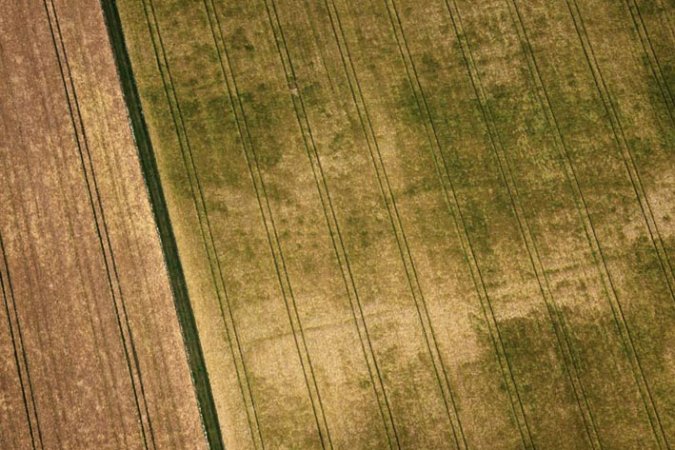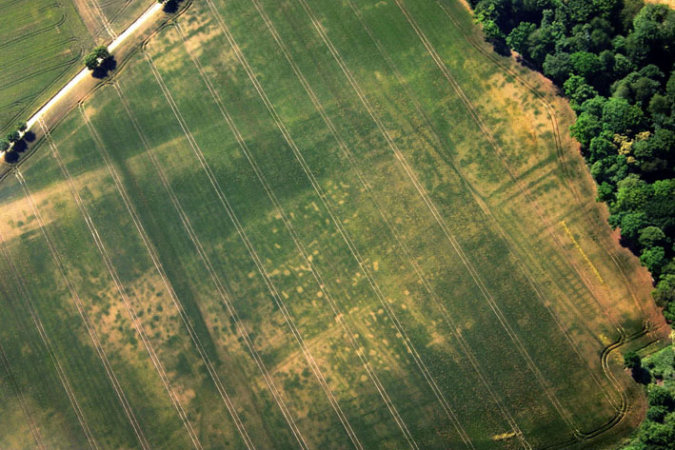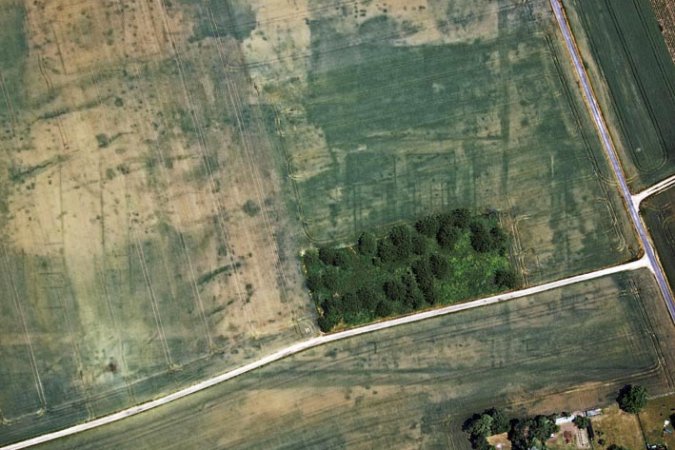Aerial Archaeology in Xanten – Vetera Castra
Contacs: Dr. Baoquan Song & Dr. Norbert Hanel
Baoquan.Song@ruhr-uni-bochum.de
Norbert.Hanel@uni-koeln.de
Since 2003 Dr. B. Song conducts aerial surveys in the area of Xanten with the emphasis on the Roman military camp Vetera castra. In collaboration with the field office LVR-Xanten (Dr. J. Obladen-Kauder) two research projects were executed between 2009 and 2010 and between 2012 and 2013 by N. Hanel and B. Song and were sponsored by the research programme of the department of North-Rhine-Westphalia.
New Aerial Images of the Legionary Camp
The evaluation of the aerial images were the central point of the project between 2009 and 2010. In the course of the systematic aerial coverage in 2003 important new discoveries in the area of the Roman military encampment could be documented. New photographic additions considerably complement our knowledge of the early imperial legionary camp and its canabae which were gained by long-standing large-scale excavations in the first third of the 20th century and by older aerial surveys from the 60s and 70s of the 20th century conducted by I. Scollar and W. Sölter. The analysis of small finds was presented by Prof. Dr. N. Hanel in his dissertation which was submitted in 1987 and published in 1995.Successive Military Encampments
Since Augustinian times at least five successive military camps have been erected on a push moraine with a high of up to 71m above sea level. They can be distinguished by their form, their alignment and size. While only sections of the breastwork of the earlier camps are known old excavations revealed parts of the interior construction of the youngest, circa 58ha large encampment. During the so called Revolt of the Batavi in 69/70 AD this complex was besieged and destroyed. Their demise was explicitly described in The Histories of Tacitus. With the exception of the amphitheatre no other traces of this important historic site at the border river of Germania Inferior.In addition to that there are large areas of the Fürstenberg that are not covered by modern buildings or dense forest. Therefore circumstances are ideal for aerial survey.
Ideal Conditions for Aerial Surveys
Due to the size of the site non-destructive survey methods are the most suitable way to gain an overview of the yet unexcavated complex areas. Additionally there are large areas of the Fürstenberg which are not disturbed by modern development or thick forests and therefore provide ideal conditions for aerial surveys.The Northern Gate of the Neronian Encampment
Due to the systematic aerial survey between 2003 and 2010 it was possible to document the groundplan of the northern gate of the Neronian military camp for two legions for the first time. Compared to the old excavations which only detected the gate trailing defensive ditches with investigative trenches, the new aerial images show the huge post settings of the gate complex (Fig. 01). The gate itself had two transits. The northern gate thereby corresponds with the already excavated porta praetoria and the porta principalis sinistra of the same encampment.
Fig. 01: The gate of the Neronian encampment.
The Areas East of the Eastern Breastwork
The areas east of the eastern breastwork beyond of the Neronian military camp for two legions showed two insightful areas:1. Directly south at the east leading road porta principalis sinistra aerial images show several parallel lying building which might have been “Streifenhäuser” (Fig.02). Indications of expansion of the associated premises at the back of the buildings have not been found yet.

Fig. 02: “Streifenhäuser” along the east leading road.
2. Several hundred meters north large-scale development traces could be detected. Those areas were not examined during the old excavations. The aerial images clearly show traces of the eastern camp fortification with an undeveloped glacis in front (Fig.03). The large-scale Roman development starts east of the glacis and spreads to the east all the way to the cut bank of the Altrhein. This housing development is probably structured by rectangular roads, which presumably had a gutter in the middle of the road. While most areas of the dense population show no obvious groundplans, traces of large buildings south of the tree-covered border path between Xanten and Birten are visible. The western building, which is north-south oriented, presumably consists of three rows of columns.
Attached to the east and rectangular to that building an east-west oriented building is situated. The side walls are flanked by two rows of chambers. The area in the middle of the building most likely is an interior courtyard. At the current state of research it is not for sure if the roads, large buildings and other findings belong to the canabae of the Neronian military camp for two legions, the older camps or to the camp settlements. Latest aerial images (Fig.04) reveal that the north-south road and probably the corresponding buildings north of the border path continue between Xanten and Birten. The traces therefore are reaching further north than the northern breastwork of the Neronian camp. In the interior of the whole Neronian military camp are further ground traces and groundplans of buildings were discovered.

Fig.03: Traces of the eastern breastwork of the camp.
